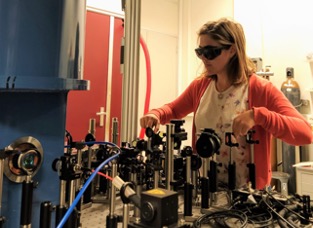When going in circles helps you stay put: how spin-orbit coupling leads to stable spins in color centers in materials

Quantum computing and communication promise to revolutionize the way in which we process and transfer information, just like transistors and the internet did in decades past. Quantum information technology allows us to process information differently than classical computing and could enable fundamentally secure communication: according to the laws of quantum mechanics, it is impossible for a third party to eavesdrop on your quantum communication channel without you knowing.
The communication between remote quantum systems is most efficiently done using particles of light – so called photons. Thus, one of the big challenges in the field is to find materials that will efficiently hold onto their quantum information and transfer it into light particles on demand. Some of the major contenders in the field are tiny blinkers present in crystalline materials like diamond or silicon, called color centers. These color centers are almost omnipresent – in fact, they are responsible for the bright color of ruby, emerald and sapphire. They behave like artificial molecules trapped in the crystals: they vibrate and interact with light like a molecule would, but the shape of these ‘artificial molecules’ is determined by the crystal around it. In a color center, electrons interact with external magnetic fields due to a fundamentally quantum mechanical property called spin. The spin can be used to store quantum information efficiently: generally, a spin interacts only with a magnet, which makes it relatively insensitive to the environment and allows it to live for a relatively long time. A photon emitted by such a color center can provide information about the quantum mechanical state of the electron spins in it.
Silicon carbide is an industrially mature semiconductor that hosts a variety of color centers, several of them interacting with light in the telecom band. This means that we can make use of the existing telecommunication infrastructure to transfer quantum information between these color centers. In some of these color centers the quantum mechanical spin property is strongly connected to the motion of the electrons (something that is called spin-orbit coupling). Since the motion of the electron is strongly influenced by its environment (the electron can bounce off other electrons or atoms, or interact with electric fields all around it), one would intuitively expect that the strong spin-orbit coupling would lead to faster loss of the quantum information stored in the spin. But this is not what researchers at the University of Groningen find, in their work published October 2020 in New Journal of Physics (https://doi.org/10.1088/1367-2630/abbf23).
In this work, the team lead by Caspar van der Wal investigates a type of color center containing molybdenum atoms in silicon carbide, which interact with light at the near-telecom range and are subject to strong spin-orbit coupling. The researchers used pulses of light to write and read the spin state in these color centers and tracked how long the stored spin information lived in these systems. They find that the spin information lived for very long in these color centers – several seconds when cooled to a temperature of 2 Kelvin (minus 270 Celsius). So, how do they explain their counter-intuitive result? In this particular ‘artificial molecule’, they crystal only allows the electrons to move in a circular path. Like a current in a coil, this circular motion creates an effective magnetic field, which interacts very strongly with the spin. Since this circular motion is pinned by the crystal, they find that spin-orbit coupling stabilizes the electron spin in these color centers, and this leads to the long-lived spins. At higher temperatures, they find that the additional vibrational motion of these ‘artificial molecules’ lead to additional interaction between the spin and the environment that destroys the spin quantum information in these systems.
Several color centers in various crystals have similar spatial properties to the Mo color center in SiC. Thus, the researchers conclude, ‘these findings shine light into what processes are actually responsible for the loss of quantum information in this class of systems. Several suitable candidates have been overlooked in the past, partly due to their strong spin-orbit coupling. However, we find that they could have surprising and promising properties for the field of quantum communication’.
| Last modified: | 27 October 2020 12.17 p.m. |
More news
-
24 March 2025
UG 28th in World's Most International Universities 2025 rankings
The University of Groningen has been ranked 28th in the World's Most International Universities 2025 by Times Higher Education. With this, the UG leaves behind institutions such as MIT and Harvard. The 28th place marks an increase of five places: in...
-
05 March 2025
Women in Science
The UG celebrates International Women’s Day with a special photo series: Women in Science.
-
16 December 2024
Jouke de Vries: ‘The University will have to be flexible’
2024 was a festive year for the University of Groningen. In this podcast, Jouke de Vries, the chair of the Executive Board, looks back.
